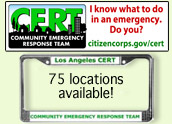2001 Emergency Preparedness Fair
Reported by Richard Wood
In 2001 the Los Angeles Emergency Preparedness Fair moved to the parking lot at Dodger Stadium. The Fair pretty much outgrew the Griffith Park Zoo parking lot where it had been held
for several years. The move allowed a much larger display area as you can see from the following pictures. It also permitted combining the Celebration of Heroes with the Fair.
The Celebration of Heroes was held for several years in Hansen Dam Recreational Area in the northeast part of the San Fernando Valley. This display and demonstration event honors
the crews and services which provide helicopter search and rescue, medical evacuation, and airborne law enforcement to their respective areas. Represented this year were agencies from all over the
Southland. Civil and military rotor wing aircraft participated. The United States Marine Corps did formation fly-bys, the Los Angeles Sheriff's Department demonstrated rappelling from a helicopter
and evacuating a victim, and all through the three days of the Fair and Celebration, helicopters arrived and departed under the watchful eye of the Civil Air Patrol. It was rather difficult to get
good pictures of landings and departures, because the public was kept at a safe distance.

On the Friday of the Preparedness Fair, it's school day. Many schools have field trips to the Fair for the children, who gather information and stamps from people
displaying their services and supplies. Getting enough stamps or initials at various stations earns the child a special patch provided by the Girl Scouts of America. The patch is secondary to the
educational opportunity this event provides for students. Of primary importance is teaching the students about emergencies and how to prepare for them. It's been said by some that everyone has a
disaster response plan. The very basic plan is, "When in danger, when in doubt, run in circles, scream and shout!" It is the one that too many people have, and the one that we in CERT have learned
to replace with improved training and education. The Friday School Day at the Fair introduces people at a young age to some healthy personal and family preparation and care which will help their
families at home for life.
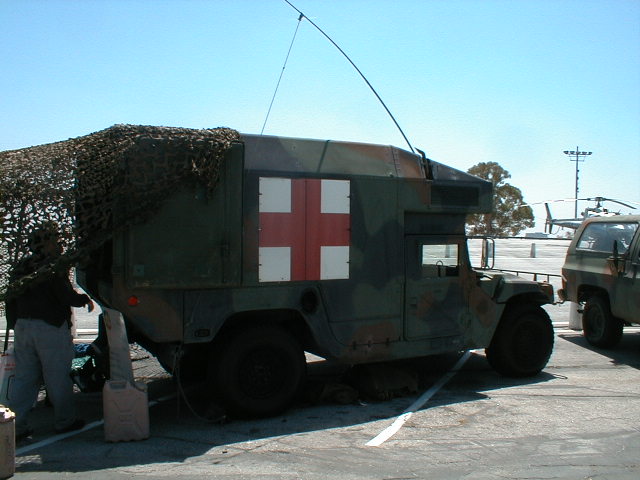
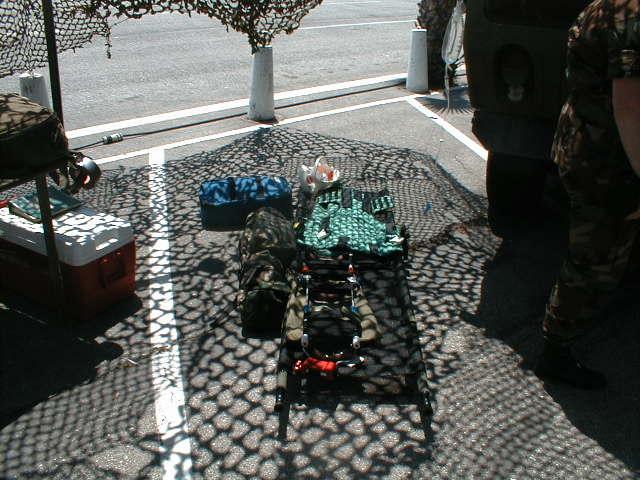
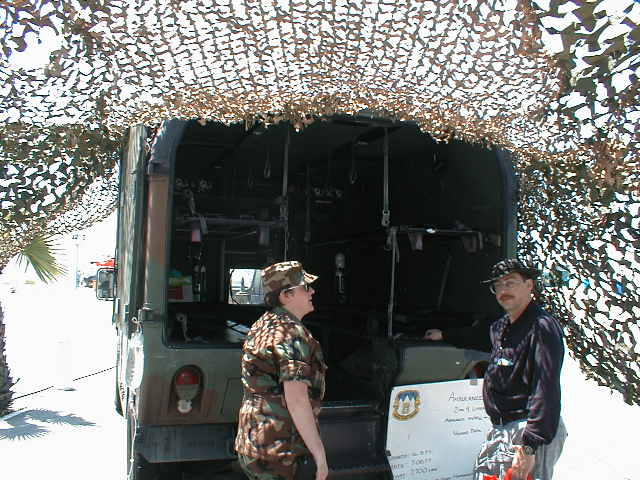
The California National Guard brought a field ambulance. This vehicle is built on a Humvee chassis, which allows it to go through deep water, and it can carry up to six people in
the stacked litters, three to a side. A central stool is mounted on a track which allows the attendant to access and continually re-assess the patients. Normally this unit is set up to carry at
most two patients. The lady you see at the left of the picture above has been with the National Guard for over 11 years, and is quite proficient in both driving and caring for
trauma.
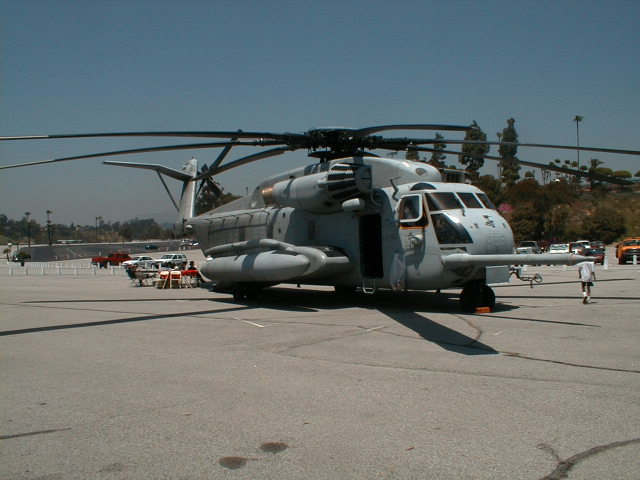
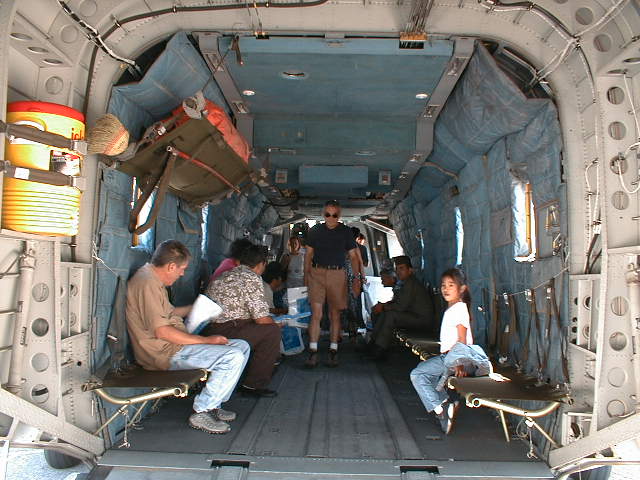
What you see above is a Marine Corps helicopter used for troop transport. It has enough space inside to carry quite a load of people and supplies, which these kinds of
units often do on extended searches. The central corridor between the facing seats can accommodate several ATV-type vehicles, many of which are being adapted for search and rescue and law
enforcement applications. We probably would not see this kind of aircraft used in an urban setting for search and rescue, though it would be ideal for bringing in supplies and evacuating injured
people in the event that freeway bridges and underpasses collapse. One does not appreciate the sheer size of this machine unless one has seen it on the ground, up close and personal.
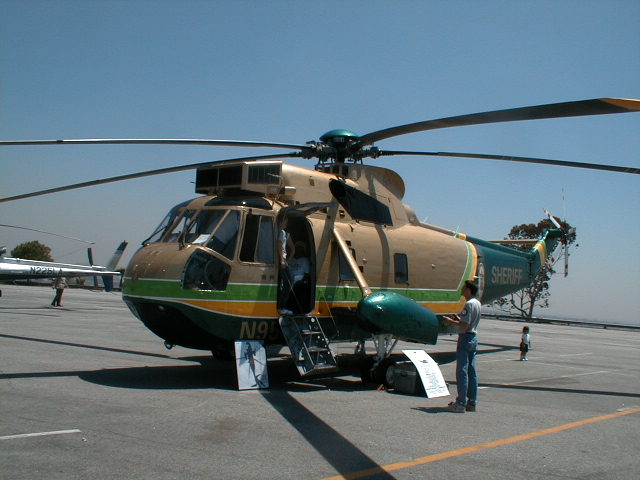
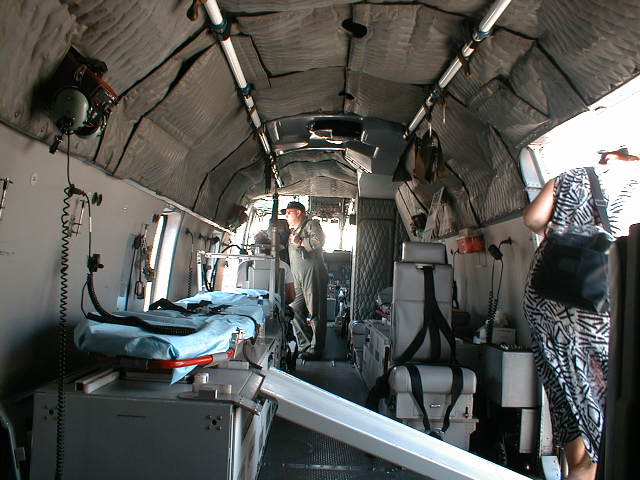
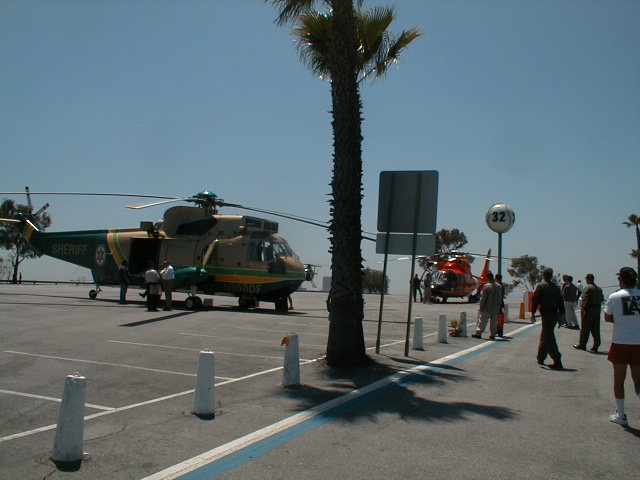
There are several Sheriff's Department Air Rescue 5 helicopters. All are Sikorsky H-3 rotor wing aircraft, carry two deputy pilots, one deputy crew chief, and two deputy
paramedics. Its maximum altitude is 14,700 feet, maximum speed is 166 mph. Empty weight is 11,600 lbs, or almost 6 tons, and maximum gross weight is 21,000 lbs. That's ten and a half tons. Rotor
diameter is 62 feet, and normal operating weight is about 16,000 lbs, or 8 tons.
Air Rescue 5 helicopters are used in airborne law enforcement, search and rescue, mountain, desert, off shore, swift water, flood rescue, air medi-vac and USAR. They can carry
sling loads up to 9,000 lbs, swat teams, squad and robot. At times of unrest, AR5 aircraft will carry civil disturbance response teams, tactical forces, state and mutual aid, disaster medical
assistance teams, and underwater search and recovery teams.
Normally configured to carry up to three patients, Air Rescue 5 can be quickly re-configured to transport up to 15 personnel. This is one of the country's finest, and the pride
and joy of County Volunteers, Reserves, and Regulars.
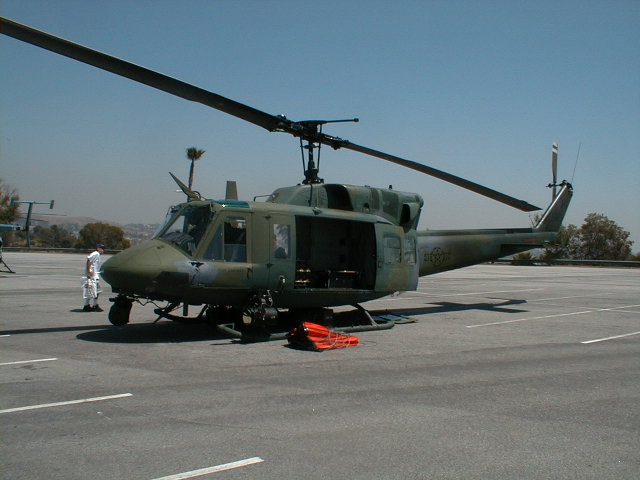
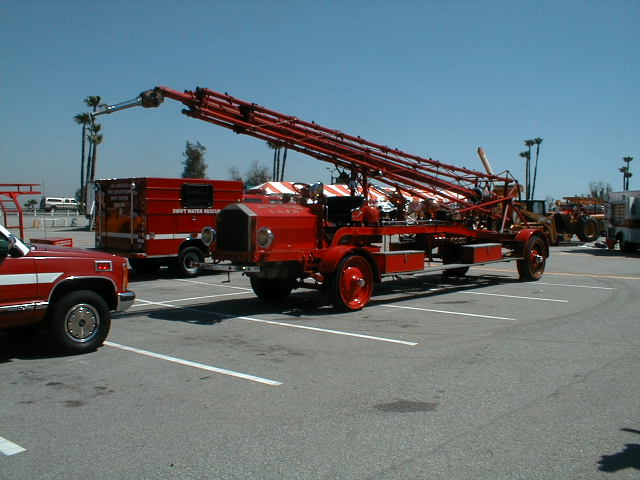
While it's a lot of fun to see the aircraft and historic vehicles at an event like this, our main focus as CERT members is first response. At minimum, we are trained as
First Responders, capable of sustaining as much survival as possible in that crucial first 72 hours after a major disaster. Below is some of the equipment that supports our kinds of efforts.
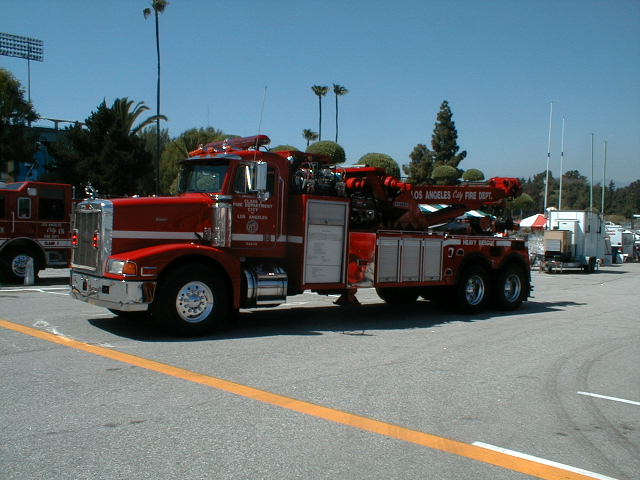
LAFD Heavy Rescue was built for the Los Angeles Fire Department in 1995 by Peterbilt and Century Wrecker. Over the years, a multitude of applications for this truck have
been discovered. Had this unit been available at the time of the Northridge Earthquake, huge amounts of large debris could have been moved sooner and probably faster. This unique wrecker can be
used for physical rescue and extrication, concrete jackhammering, river rescue, structural collapse, high-angle rope rescues, confined space rescue support, lifting of extremely heavy objects, and
anywhere a crane would be useful. The replacement cost today would be about $300,000, plus about $100,000 for tools and equipment.
Tools and equipment currently carried include an acetylene torch, heavy-lift air bags, capstan winch, cribbing, rotary saw, Hurst Rescue Tool ("Jaws of Life"), and Hurst ram
sets. Normal staffing for this truck is one Apparatus Operator and one Firefighter.
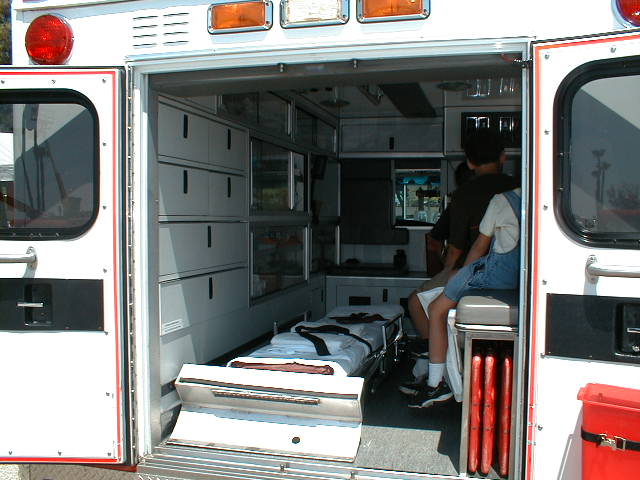

Above to the left you see the back of an ambulance equipped with the normal gurney, which is adequate for most urban operations. This is the kind of advanced life support
ambulance you might see at a traffic accident or on a neighborhood response to heart attack or trauma. Usually these ambulances have at least one paramedic, usually two, and often will have a third
crew member to drive, especially if complications are expected.
Above right you can see a similar ambulance, but with the more rugged gurney that is gaining popularity. These rugged gurneys offer a much more stable transportation option, and
can be used on dirt surfaces and some offroad rescues. This kind of gurney is used for rescues in parks because the wider and larger wheels permit operation on grass and rough
surfaces.

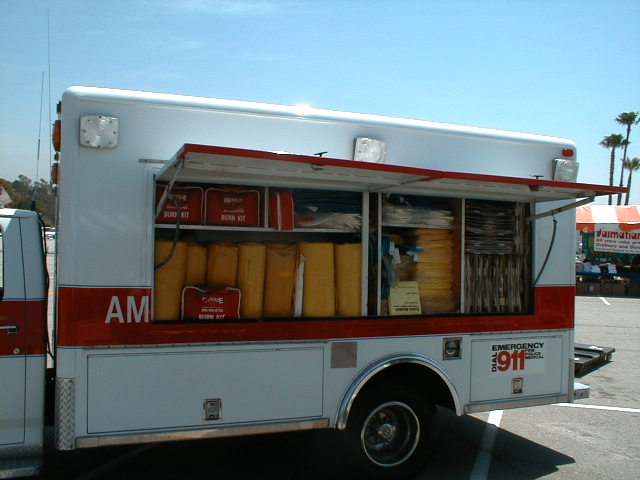
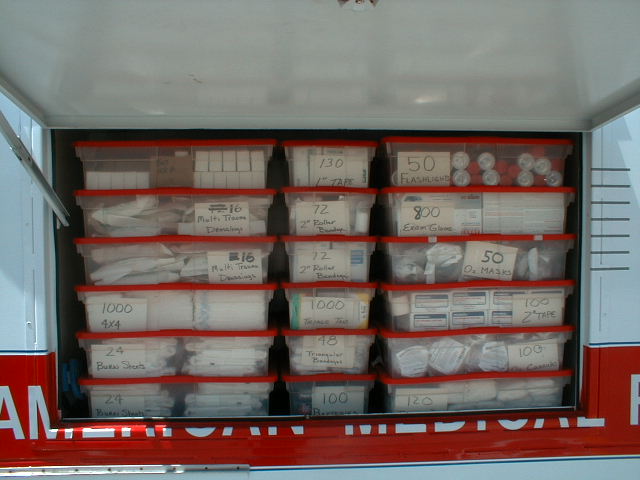
The truck above is a mass casualty medical support vehicle. This American Medical Response vehicle carries large quantities of medical supplies. Ambulances can be
re-stocked by this unit, and field hospitals and treatment areas can be supported as well. This is an excellent example of what private industry has contributed to community disaster preparedness
and response.
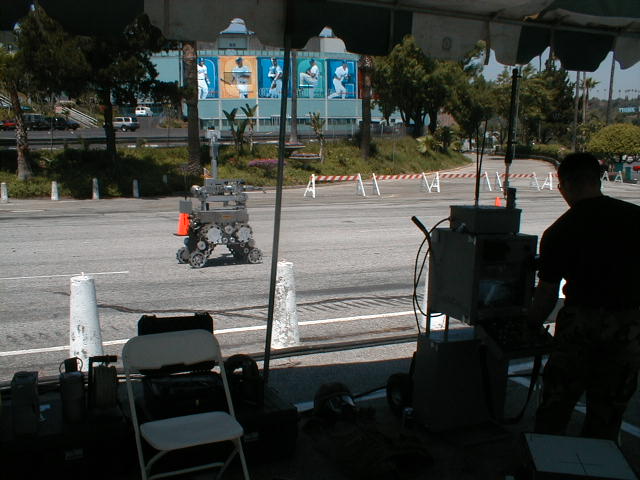
Usually we see these all-terrain robots on TV supporting law enforcement. They have a video camera on board, which allows the operator to guide it to its target area. The
articulated treads permit going up and down stairs, and a light will show the way in the dark and often keep a suspect at bay. The 'entry tool' at the front can blast a lock from a door.
In search and rescue operations, this kind of robot can search areas which may be hazardous to humans. By sending in a robot, the operators can determine if there are people who
need rescuing. If not, rescuers and their resources are better applied elsewhere.
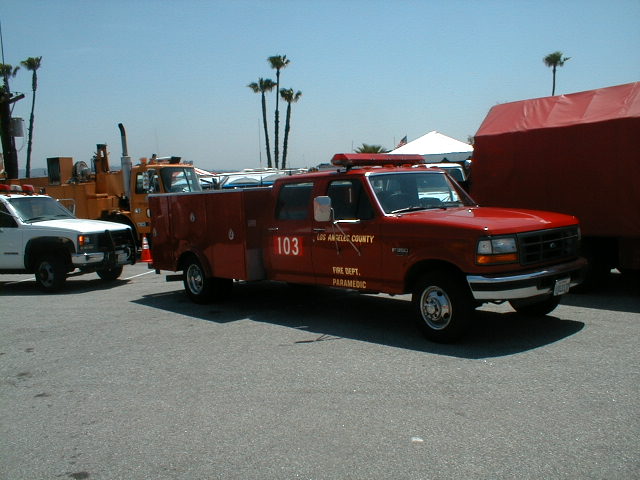
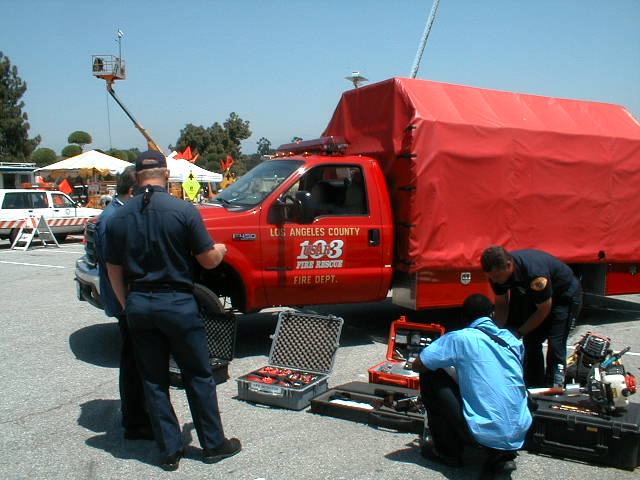
The Los Angeles County Fire Department covers a more rural area, and in most cases more isolated. These two trucks are part of the County system of emergency response. The
Paramedic Squad on the left carries two, sometimes three paramedics. The utility body of the vehicle carries basic and advanced life support equipment. The county contracts with private ambulance
companies for the transport portion of Emergency Medical Services, which permits the vehicle to carry a larger complement of equipment and supplies to support the usually more protracted rescues.
The truck on the right carries a large complement of rescue support equipment, such as breathing apparatus, jacks and cribbing supplies, video cameras and extra-sensitive listening
equipment.

The highlight of Saturday was the BICEPP Challenge. The Business and Industry Council for Emergency Planning and Preparedness is a strong supporter of emergency
preparedness and the CERT training program. The people above are getting ready to enter the activities.
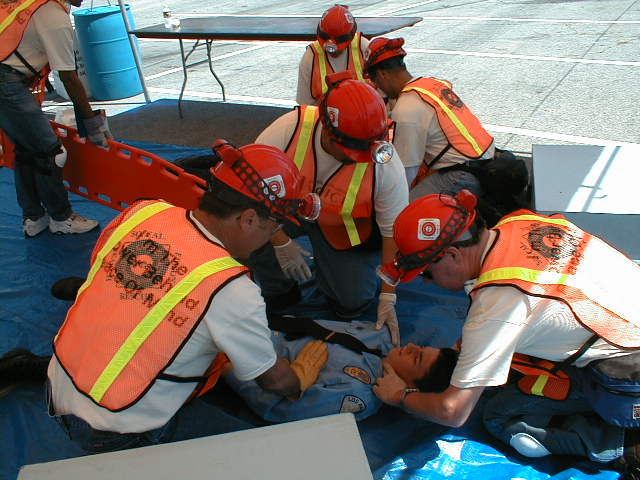
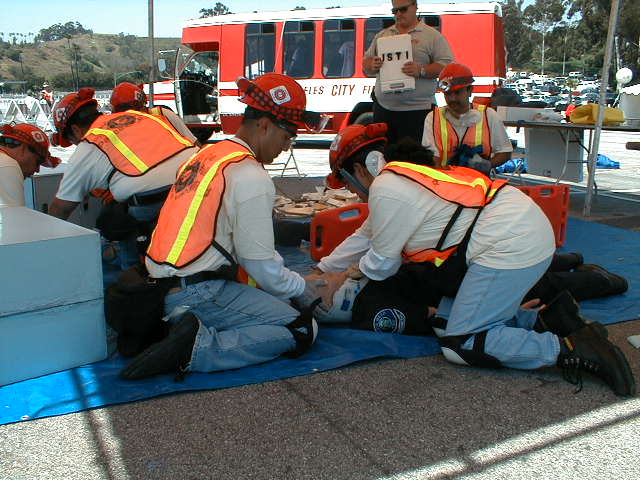
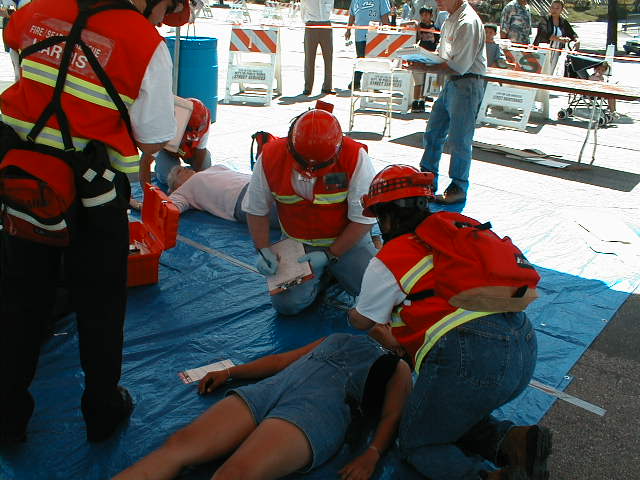
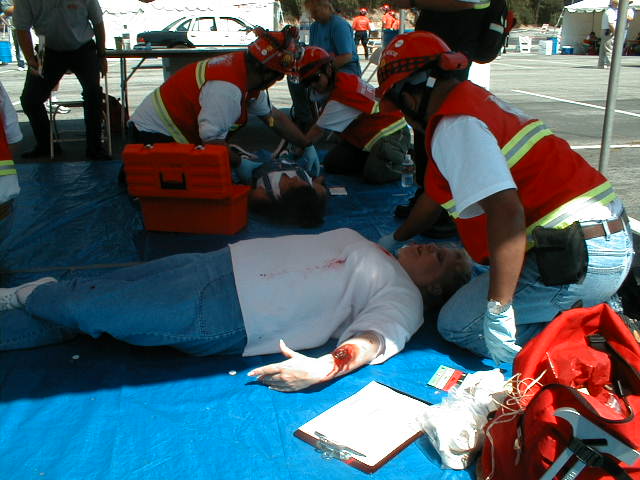
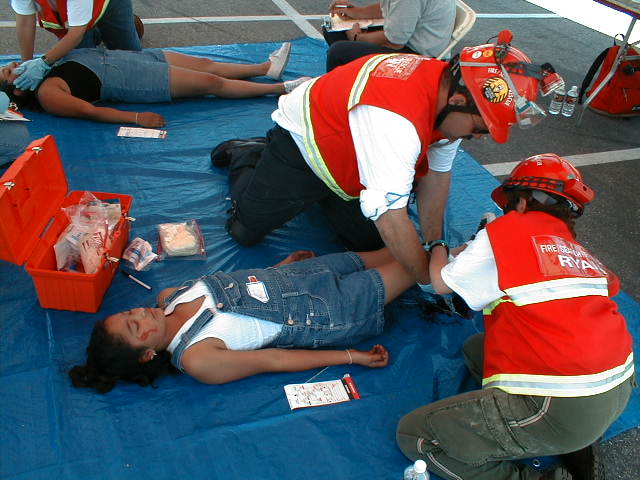
The stations were quite realistically set up to represent several emergency search and rescue scenarios. Rapid victim assessment was stressed, and the participants were
timed as well as having their documentation examined for accuracy and completeness.
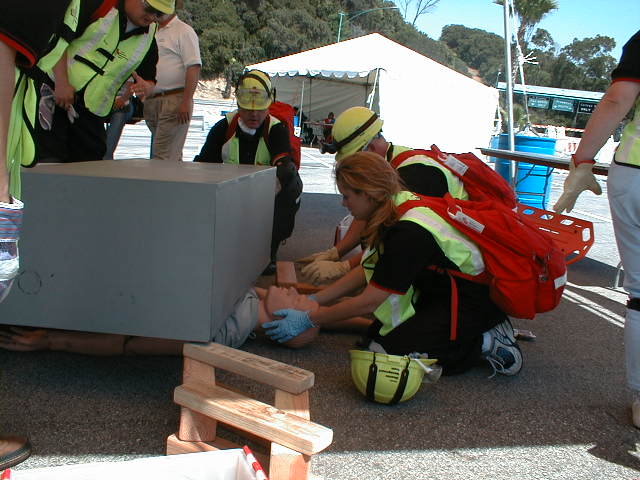
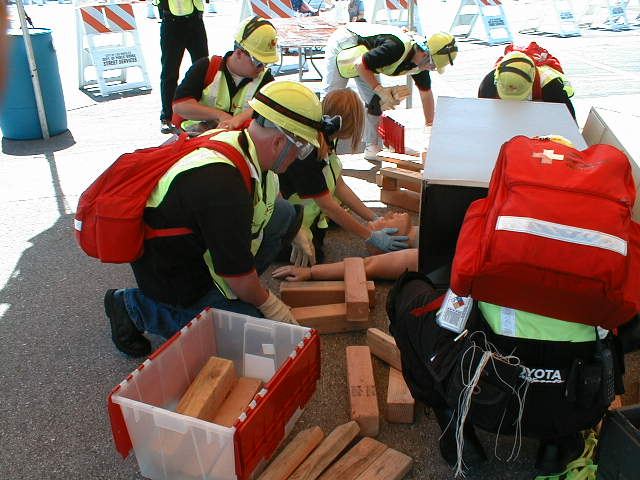
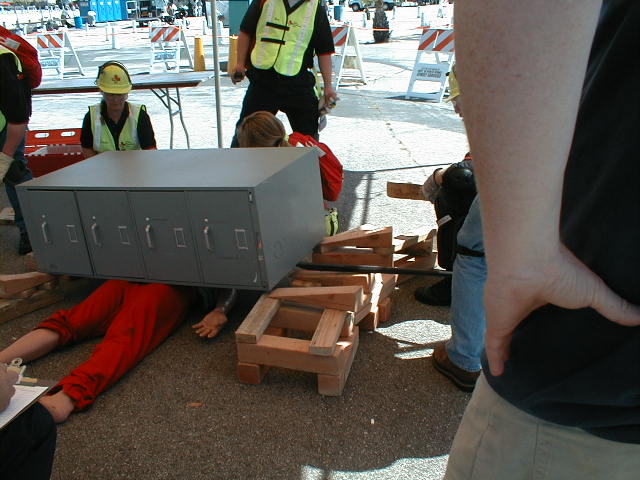
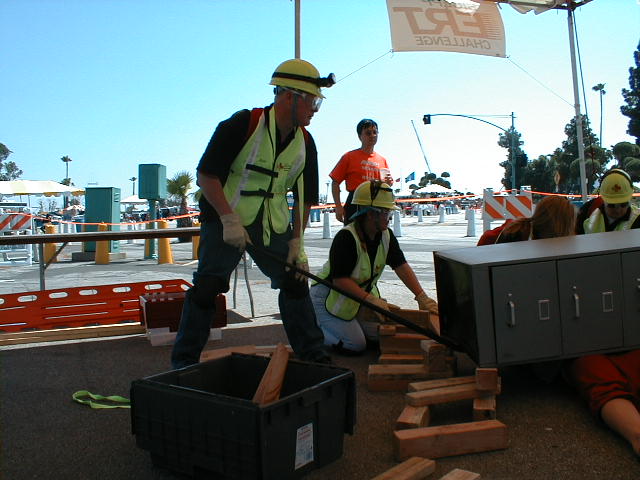
Mannequins were rescued using proper bar coordination and cribbing. These teams worked with a good rapid pace, wasting very little motion and effort. Make no mistake, this
was hard work for them all, but their training and practice brought them through quite successfully and rapidly.
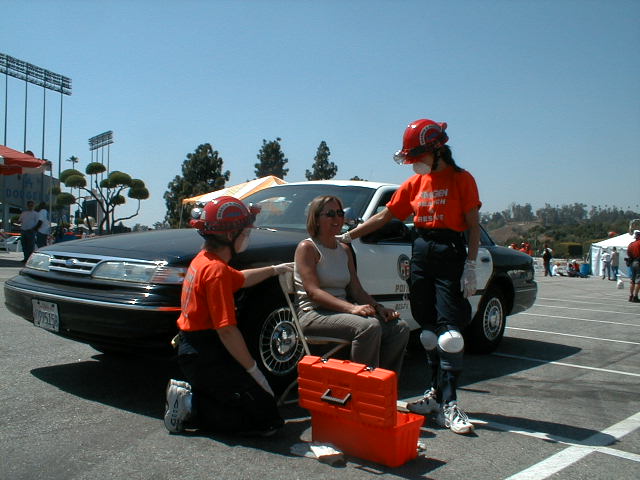
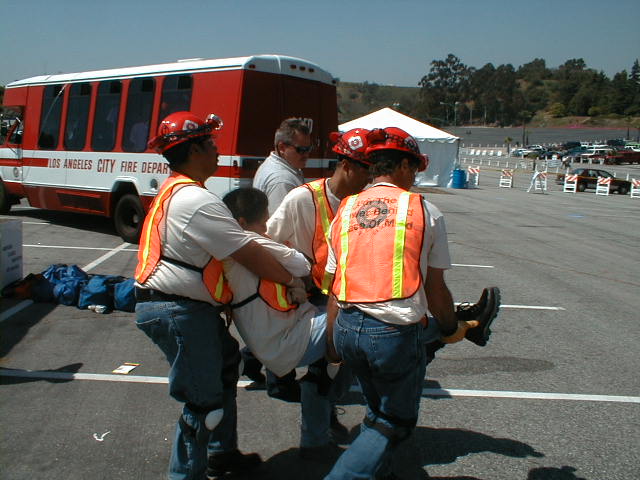
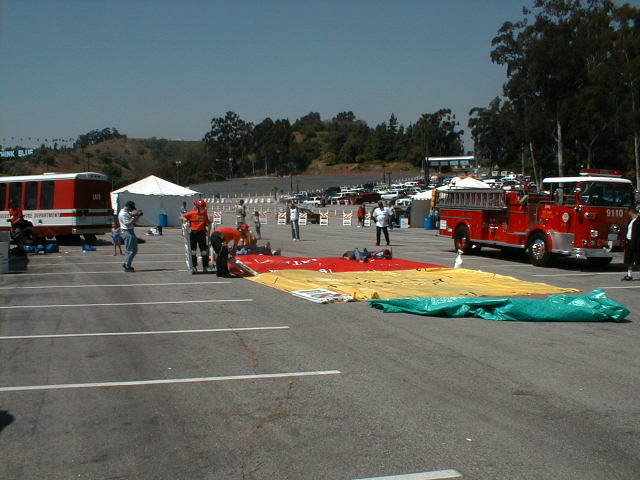
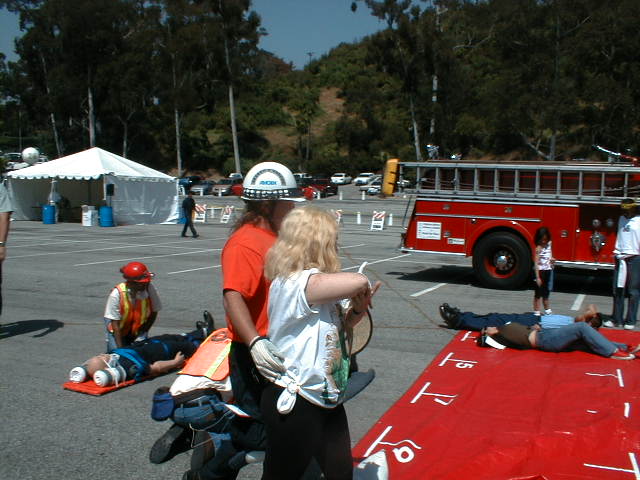
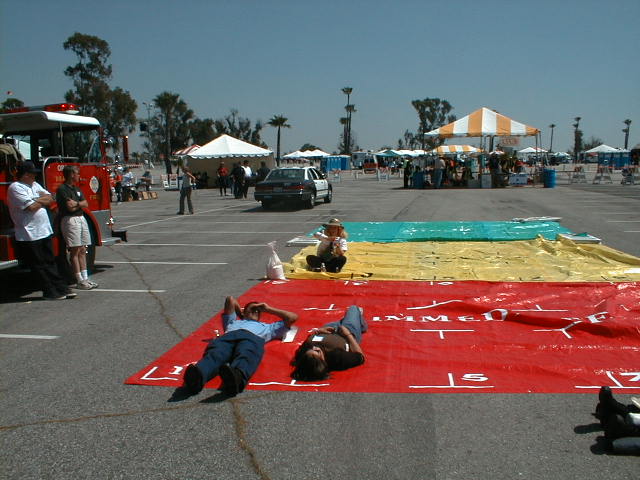
Triage and transportation are an important part of a mass casualty incident. Often some treatment is initiated near the scene while awaiting a crew to transport the victim
to the treatment areas for more complete assessment and treatment. The red tarp is used for those needing immediate care and transportation, such as severe bleeding, altered levels of
consciousness, and suspected head, neck and spinal cord injuries. The yellow tarp is used for those whose treatment and transport can wait a while, such as closed bone fractures, sprains, and those
with superficial injuries which are easily controlled. The green tarp is for those with minor injuries which may not need a higher level of intervention. It is still an important area, because
these are probably the best witnesses for investigators, and often they can be used to help hold pressure dressings to control bleeding or watch someone for drastic changes in the other two
areas.
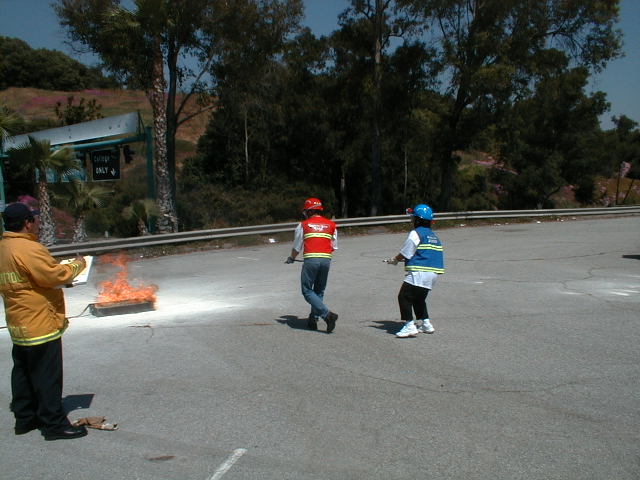
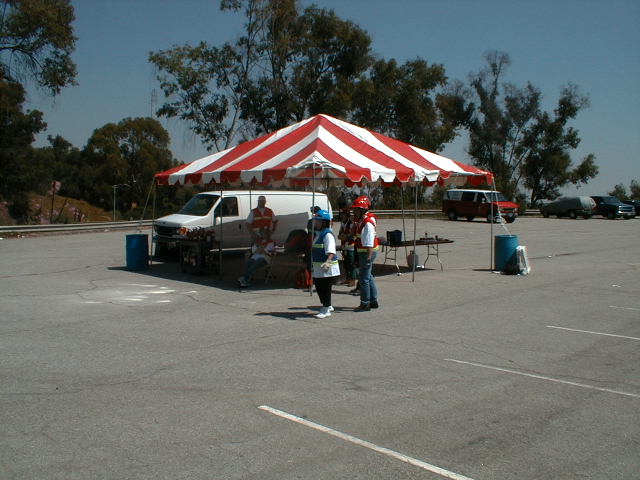
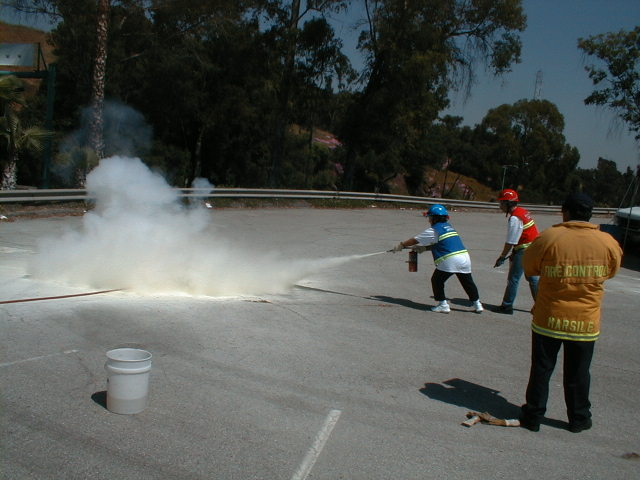

Fire is always a danger in any disaster situation. Here the teams are rapidly advancing on, extinguishing, and withdrawing from a fire. Several people were evaluating the
speed and accuracy of the work. While the official training may not be the only way to accomplish the job, there is no argument that the procedures we have been taught by the firefighters work. The
advantage of everyone using the same approach and the same technique is that we then become relatively interchangeable among teams, which makes our participation and our contribution as strong as
possible.





